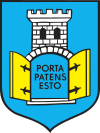 Alternate names: Gołańcz [Pol], Gollantsch [Ger]. 52°57' N, 17°18' E, 32 miles WSW of Bydgoszcz (Bromberg). Słownik Geograficzny Królestwa Polskiego (1880-1902), II, p. 662: "Gołańcz". The prominent British Jewish family of Gollancz originated in this town. Gmina Gołańcz is an urban-rural administrative district in Wągrowiec County, Greater Poland Voivodeship, in west-central Poland. Its seat is the town of Gołańcz, which lies approximately 18 km (11 mi) NE of Wągrowiec and 67 km (42 mi) NEt of the regional capital Poznań. 2006 its total population is 8,391 (out of which the population of Gołańcz amounts to 3,342, and the population of the rural part of the gmina is 5,049).Gmina villages and settlements of Bogdanowo, Brdowo, Buszewo, Chawłodno, Chojna, Czerlin, Czesławice, Czeszewo, Grabowo, Gręziny, Jeziorki, Konary, Krzyżanki, Kujawki, Laskownica Mała, Laskownica Wielka, Lęgniszewo, Morakówko, Morakowo, Oleszno, Panigródz, Potulin, Rybowo, Smogulec and Tomczyce. [May 2009]
Alternate names: Gołańcz [Pol], Gollantsch [Ger]. 52°57' N, 17°18' E, 32 miles WSW of Bydgoszcz (Bromberg). Słownik Geograficzny Królestwa Polskiego (1880-1902), II, p. 662: "Gołańcz". The prominent British Jewish family of Gollancz originated in this town. Gmina Gołańcz is an urban-rural administrative district in Wągrowiec County, Greater Poland Voivodeship, in west-central Poland. Its seat is the town of Gołańcz, which lies approximately 18 km (11 mi) NE of Wągrowiec and 67 km (42 mi) NEt of the regional capital Poznań. 2006 its total population is 8,391 (out of which the population of Gołańcz amounts to 3,342, and the population of the rural part of the gmina is 5,049).Gmina villages and settlements of Bogdanowo, Brdowo, Buszewo, Chawłodno, Chojna, Czerlin, Czesławice, Czeszewo, Grabowo, Gręziny, Jeziorki, Konary, Krzyżanki, Kujawki, Laskownica Mała, Laskownica Wielka, Lęgniszewo, Morakówko, Morakowo, Oleszno, Panigródz, Potulin, Rybowo, Smogulec and Tomczyce. [May 2009]
US Commission No. POCE000432
German name: Sollantsch. Located in Pika at 52º57N 17º18E, 40 km from Bydgoszcz. Cemetery is N of town, near the road to Podjezien(?)e. Present town population is 1,000 to 5,000 with no Jews.
- Town: Chzad Miesta I Gminy w Goteucry.
- Local: Mgr. Roman Chwaliszewski, Wojensdrus Konserwator Zabytkow, 64-920 Pita ul. Tczewsko 1. tel. 223-88.
- Regional: Paustwowa Sluiba odwomy Zabytkow addriar 21 Pile, Mgr. Barbara Kuczynska; adres j.w.
- Interested: Mgr. Mavek Fijatuowski, Muzeum Olivegowe, 64-920 Pita ul. Chopina 7. tel. 271-37.
In 1768, permission was granted to restore the synagogue; then, they built a new masonry building. The Jewish population as of last census before World War II was 50. The cemetery was established in the 18th century with last Progressive/Reform Jewish burial before 1939. The isolated suburban flat land has no sign or marker. Access is open to all. A broken masonry wall with no gate surrounds the cemetery. Approximate size of cemetery before World War II was 0.50 ha, presently the same. No gravestones or mass graves exist. Municipality owns property now used for recreation. Local residents rarely visit. It was vandalized during World War II. There is no maintenance, structures or threats.
Henryk Grecki, 70-534 Szczecin Soktysia 3/13, Tel. 377-41 completed survey August 30, 1981. The site was not visited.
